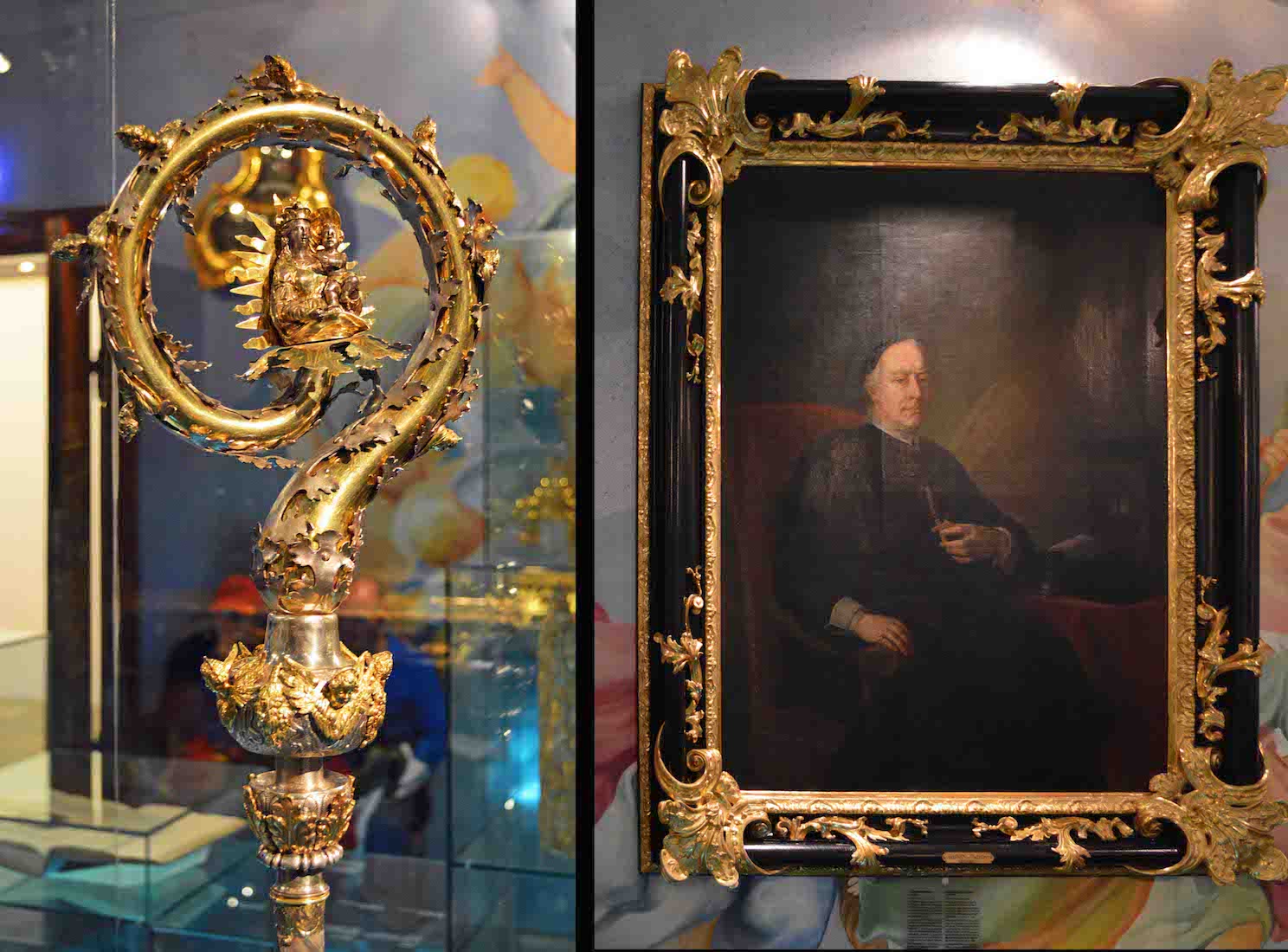22. CROSS, INCENSE BOAT, MONSTRANCE

At left is a glass (crystal?) cross, perhaps designed to hold a relic. Centre is an incense boat, and at right a highly decorative monstrance. The incense boat is a container of incense kept on hand in case the incense in the thurible burns low.
23. PAINTINGS
The painting at left shows St Peter holding a very large key. At right we may have a picture of St Catherine, indicated by the small wheel.
24. PAINTING
I have no description of this scene, but my guess is that it shows Christ defending Melk Abbey from the battle raging around it.
25. ABBEY LIFE
This is one of two panels from a 15th century manuscript. This one shows monastic life after the Melk Reform. During the 15th century, the abbey became the center of the Melk Reform movement which reinvigorated the monastic life of Austria and Southern Germany. The abbey's influence undoubtedly helped save the monastery from Emperor Joseph II several centuries later when many other Austrian abbeys were seized and dissolved.
26. ROOM 4, CRUCIFIX
Room 4 is subtitled ‘The Wood of Life’. Here we find this late Romanesque crucifix. It came originally from the oldest church in Vienna, and was given to Melk Abbey in 1799.
27. ROOM 5
Room 5 is a room of mirrors, and is subtitled ‘Now we are seeing a dim reflection in a mirror’. Nothing was beautiful and wonderful enough for the Baroque. Everything shone, man reflected himself in a beautiful world and was deeply happy in his faith. Here is an expression of 1 Cor 13:12.
28. DANCING FIGURES
In the mirror room are several groups of golden robed dancing figures. With all the mirror reflections it is difficult to tell how many!
29. SPLENDOUR!
With the bright chandeliers, the reflecting display cabinets and exhibits, and gold decorations, the crowd enjoys the splendour which overwhelms the senses.
30. CHALICES AND MONSTRANCES
The chalice is the cup which holds the communion wine. The monstrance is the device with which the priest conveys the Blessed Sacrament in ceremonial procession. The monstrance was often very elaborate in its design, but these chalices would have been used only on special occasions. .
31. FURTHER DISPLAYS
Here is a further chalice and two more monstrances. Immense time, effort and money went into the creation of these valued items.
32. ROOM 6, MITRE
Room 6 is subtitled ‘Heaven on Earth’. Medieval art was very human, showing joy in splendour, in all that was beautiful and good. As well it sought to glorify God and be like an image of God, who was the living centre of the lives of these men. Shown is the Pearl Mitre of c1750 – all that remains of a complete set of vestments which had to be sold in the Baroque period to pay war taxes.
33. ABBOT BERTHOLD DIETMAYR MONOGRAM
The walls of Room 6 are covered with images of cherubs and angels along with curious gold ornaments. Since the room features Abbot Berthold Dietmayr, it seems reasonable to assume that these are ‘BD’ monograms. Dietmayr (1700 – 1739) commissioned the reconstruction of the Abbey.
34. CRUCIFIX
The Crucifixion is a key part of the Christian story. It is fair to say that the crucifix is more prominently displayed in the Roman Catholic tradition than in the Protestant, which prefers to concentrate on the ‘Risen Christ’.
35. PASTORAL STAFF, ABBOT DIETMAYR
The Abbot’s staff (‘Mary-Pastoral’) is unusual and features an image of the crowned Mary holding the Child Jesus. The painting is of Abbot Dietmayr. The major Baroque reconstruction of the Abbey took place during his time in office.
36. COPES
The various displays of pontifical shoes, gloves, copes, and mitres are intended to illustrate the exceptionally festive vestments of the Abbott for the High Mass.
37. ROOM 7, REUSABLE COFFIN
We move on to Room 7, subtitled ‘In the Name of Reason’. In time there was a reaction against the excesses of the Baroque period, and rationalism became the most important thing. In this thinking, reason and faith together are a possible path for our earthly life. In Room 7 it is a surprise to find a rather ordinary looking coffin. However, it turns out it’s an eco-friendly, reusable coffin. It only had brief appeal before being forever banished to spending life in a museum.
38. LEATHER VESTMENTS
A further practical reaction against the Baroque came in these leather vestments: practical, long lasting, and probably uncomfortable!
39. ROOM 8: THE WHOLE PERSON
Room 8 is subtitled ‘The Whole Person’. The idea here is the growth and fulfilment of the person. This is shown by a human body gradually appearing in 11 steps. The 12th step, which is man in his entirety, is the visitor himself.
40. ROOM 9: THE PATH TO THE FUTURE
Room 9 is subtitled ‘The Path to the Future’. It is a room of paintings. Here we reflect that the Melk Abbey community has continued on its way for 900 years. This is a path of faith which looks for God in everyday life.




















